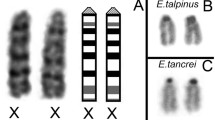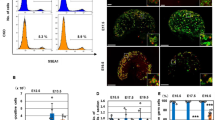Abstract
Parallel to the inactivation of the X chromosome in somatic cells of female, the male X in mammals is rendered inactive during spermatogenesis. Pseudoautosomal genes, those present on the X-Y meiotically pairable region of male, escape inactivation in female soma. It is suggested, but not demonstrated, that they may also be refractory to the inactivation signal in male germ cells. We have assayed activity of the enzyme steroid sulfatase, product of a pseudoautosomal gene, in testicular cells of the mouse and shown its presence in premeiotic, meiotic (pachytene), and postmeiotic (spermatid) cell types. It appears that, as in females, pseudoautosomal genes may escape inactivation in male germ cells also.
Similar content being viewed by others
References
Lyon, M.F. (1961).Nature 190372–373.
Monesi, V., Geremia, R., D'Agostino, A., and Boitani, C. (1978).Curr. Top. in Dev. Biol. 1211–36.
Chandley, A.C. (1981).Ann. Genet. 245–11.
Forejt, J. (1982). InGenetic Control of Gamete Production, (eds.) Crosignani, P.G., Rubin, B.L., and Fraccaro, M. (Academic Press/Grune & Straton, London), pp. 135–151.
Lifschytz, E., and Lindsley, D.L. (1972).Proc. Natl. Acad. Sci. U.S.A. 69182–186.
VandeBerg, J.L., Robinson, E.S., Samollow, P.B., and Johnston, P.G. (1987). InIsozymes: Current Topics in Biological and Medical Research. Genetics, Development and Evolution, (A.R. Liss, New York)Vol. 15, pp. 225–253.
Erickson, R.P. (1976).Dev. Biol. 53134–137.
Hotta, Y., and Chandley, A.C. (1982).Gamete Res. 665–72.
Boer, P.H., Adra, C.N., Lau, F.-Y., and McBurney, M.W. (1987).Mol. Cell. Biol. 73107–3112.
Shapiro, L.J., Mohandas, T., Weiss, T., and Romeo, G. (1979).Science 2041224–1226.
Goodfellow, P., Pym, B., Mohandas, T., and Shapiro, L.J. (1984).Am. J. Hum. Genet. 36777–782.
Keitges, E.A., Rivest, M., Siniscalco, M., and Gartler, S.M. (1985).Nature 315226–227.
Goodfellow, P., Banting, G., Sheer, D., Ropers, H.H., Caine, A., Ferguson-Smith, M.A., Povey, S., and Voss, R. (1983).Nature 302346–349.
Burgoyne, P.S. (1982).Hum. Genet. 6185–90.
Petit, C., Levilliers, J., and Weissenbach, J. (1988).EMBO J. 72369–2376.
Royer, F., Simmler, M-C., Johnsson, C., Vergnaud, G., Cooke, H.J., and Weissenbach, J. (1986).Nature 319291–295.
Burgoyne, P.S., and McLaren, A. (1985).Hum. Genet. 7082–83.
Yen, P.H., Marsh, B., Allen, E., Tsai, S.P., Ellison, J., Connolly, L., Neiswanger, K., and Shapiro, L.J. (1988).Cell 551123–1135.
Meistrich, M.L. (1977). InMethods in Cell Biology, (ed.) Prescott, D.M. (Academic Press, New York),15 pp. 15–54.
Lowry, O.H., Rosebrough, N.J., Farr, A.L., and Randall, R.J. (1951).J. Biol. Chem. 193265–275.
Mohandas, T., Shapiro, L.J., Sparkes, R.S., and Sparkes, M.C. (1979).Proc. Natl. Acad. Sci. U.S.A. 765779–5783.
Munroe, D.G., and Chang, P.L. (1987).Am. J. Hum. Genet. 40102–114.
Wiberg, U.H., and Fredga, K. (1987).Hum. Genet. 776–11.
Ropers, H.H., and Wiberg, V. (1982).Nature 296766–767.
Keitges, E., and Gartler, S.M. (1986).Am. J. Hum. Genet. 39470–476.
Crocker, M., and Craig, I. (1983).Nature 303721–722.
Jones, J., Peters, J., Rasberry, C., and Cattanach, B.M. (1989).Genet. Res. 53193–199.
Gauthier, R., Vigneault, N., Bleau, G., Chapdelaine, A., and Roberts, K.D. (1978).Steroids 31783–798.
Chandley, A.C. (1986).Hum. Genet. 7250–57.
Raman, R., Singh, A.P., and Nanda, I. (1988).J. Cell Sci. 90629–634.
Shapiro, L.J. (1985). InAdvances in Human Genetics (eds.) Harris, H., and Hirschhorn, K. (Plenum, New York)14 pp. 331–381.
Brown, C.J., Ballabio, A., Rupert, J.L., Lafreniere, R.G., Grompe, M., Tonlorenzi, R., and Willard, H.F. (1991).Nature 34938–44.
Author information
Authors and Affiliations
Rights and permissions
About this article
Cite this article
Raman, R., Das, P. Mammalian sex chromosomes III. Activity of pseudoautosomal steroid sulfatase enzyme during spermatogenesis inMus musculus . Somat Cell Mol Genet 17, 429–433 (1991). https://doi.org/10.1007/BF01233166
Received:
Revised:
Issue Date:
DOI: https://doi.org/10.1007/BF01233166




